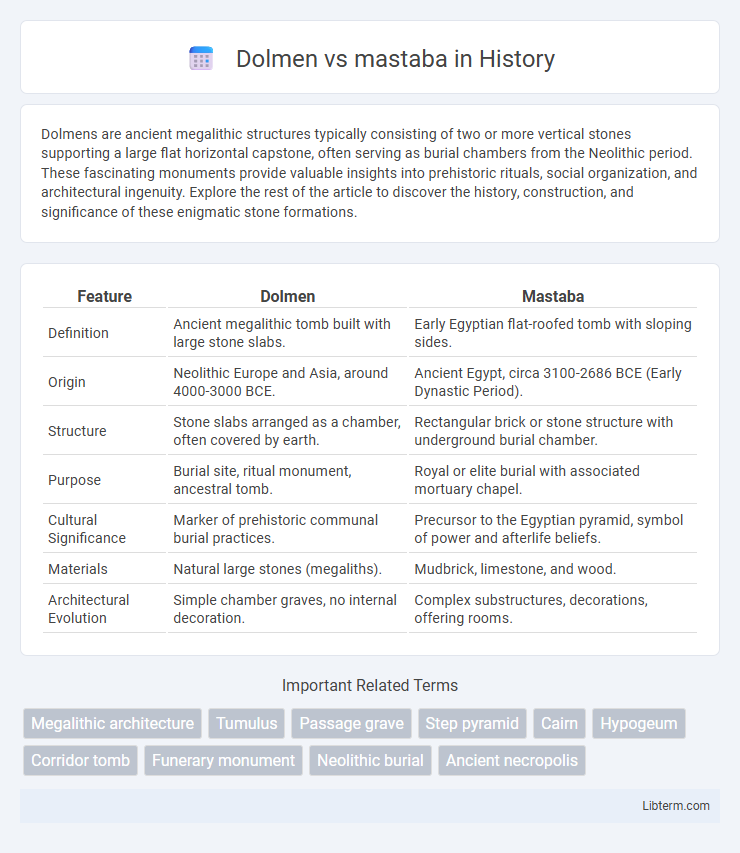Dolmens are ancient megalithic structures typically consisting of two or more vertical stones supporting a large flat horizontal capstone, often serving as burial chambers from the Neolithic period. These fascinating monuments provide valuable insights into prehistoric rituals, social organization, and architectural ingenuity. Explore the rest of the article to discover the history, construction, and significance of these enigmatic stone formations.
Table of Comparison
| Feature | Dolmen | Mastaba |
|---|---|---|
| Definition | Ancient megalithic tomb built with large stone slabs. | Early Egyptian flat-roofed tomb with sloping sides. |
| Origin | Neolithic Europe and Asia, around 4000-3000 BCE. | Ancient Egypt, circa 3100-2686 BCE (Early Dynastic Period). |
| Structure | Stone slabs arranged as a chamber, often covered by earth. | Rectangular brick or stone structure with underground burial chamber. |
| Purpose | Burial site, ritual monument, ancestral tomb. | Royal or elite burial with associated mortuary chapel. |
| Cultural Significance | Marker of prehistoric communal burial practices. | Precursor to the Egyptian pyramid, symbol of power and afterlife beliefs. |
| Materials | Natural large stones (megaliths). | Mudbrick, limestone, and wood. |
| Architectural Evolution | Simple chamber graves, no internal decoration. | Complex substructures, decorations, offering rooms. |
Introduction to Ancient Burial Structures
Dolmens and mastabas represent distinct ancient burial structures reflecting early funerary architecture. Dolmens, typically made of large upright stones supporting a horizontal capstone, served as communal tombs across Neolithic Europe and Asia. Mastabas, originating in ancient Egypt, are rectangular, flat-roofed brick or stone structures with sloping sides, designed as elite tombs marking the precursor to the pyramidal form.
Defining Dolmen: Origins and Features
Dolmens are ancient megalithic tomb structures originating primarily in Neolithic Europe and Asia, characterized by large flat stones supported by upright ones, forming a simple chamber. These structures served as burial sites and are often associated with ritualistic purposes, reflecting early human architectural ingenuity in commemorating the dead. Unlike mastabas, which are rectangular superstructures with sloping sides from ancient Egypt, dolmens emphasize post-and-lintel construction using unhewn stones.
Understanding Mastaba: Architecture and History
Mastabas are ancient Egyptian tomb structures characterized by rectangular, flat-roofed forms with outward sloping sides, typically constructed from mudbrick or stone, dating back to the Early Dynastic Period and Old Kingdom. These tombs served as burial sites for elite individuals, featuring subterranean chambers beneath the superstructure for the deceased and offering rooms for funerary rituals. Unlike the simplistic megalithic dolmen, mastabas exhibit early architectural sophistication and cultural significance, reflecting Egypt's evolving mortuary practices and religious beliefs.
Geographic Distribution: Dolmen vs Mastaba
Dolmens predominantly appear across Western Europe, especially in regions like Ireland, France, and the British Isles, while mastabas are primarily found in ancient Egypt along the Nile Valley. Dolmens serve as prehistoric megalithic tombs dating back to the Neolithic period, whereas mastabas functioned as early Egyptian funerary structures during the Early Dynastic and Old Kingdom periods. This geographic distinction highlights cultural variations in burial architecture between European megalithic societies and ancient Egyptian civilization.
Construction Techniques Compared
Dolmens are megalithic tombs constructed using large upright stones supporting a flat horizontal capstone, relying on dry stone technique and simple post-and-lintel framework. Mastabas, originating in ancient Egypt, are rectangular structures made from mud bricks or stone blocks with sloping sides, featuring a subterranean burial chamber accessed through vertical shafts. Dolmen construction emphasizes monumental stone assembly above ground, whereas mastaba construction involves layered brick or stone masonry combining above-ground superstructure with underground burial chambers.
Cultural and Religious Significance
Dolmens, originating from Neolithic Europe, primarily served as communal burial sites symbolizing ancestor worship and were often associated with early spiritual beliefs about the afterlife. Mastabas, developed in ancient Egypt, functioned as tombs for elite individuals, reflecting complex religious doctrines tied to the journey of the soul and the afterlife in Egyptian mythology. Both structures embody significant cultural rituals but differ in religious context; dolmens emphasize collective commemoration, while mastabas underscore individual immortality and divine status.
Artifacts and Burial Practices
Dolmens typically consist of large stone slabs forming a chamber used for collective burials, often containing pottery, tools, and personal ornaments as artifacts. Mastabas, characterized by their rectangular superstructure and subterranean burial chamber, frequently house elaborate grave goods such as jewelry, statues, and funerary inscriptions. Burial practices in dolmens emphasize communal interment with minimal individual differentiation, whereas mastabas reflect hierarchical social structures with more individualized and richly furnished tombs.
Evolution into Later Tomb Types
Dolmens, originating as simple megalithic burial chambers, evolved into more complex structures such as passage graves and stone barrows, reflecting advancements in architectural techniques and social organization. Mastabas, early Egyptian tombs characterized by their flat-roofed, rectangular shape, served as precursors to the stepped pyramid, marking a significant evolution in funerary architecture with increasing emphasis on symbolic representation and elite status. The transition from dolmens and mastabas to later tomb types illustrates the cultural shift towards monumental and durable burial practices in ancient societies.
Archaeological Discoveries and Insights
Dolmens, primarily found in Europe and Asia, are megalithic tomb structures consisting of two or more vertical stones supporting a large flat horizontal capstone, serving as burial sites or ritual monuments. Mastabas, originating from Ancient Egypt, are rectangular, flat-roofed tombs made of mudbrick or stone, containing underground burial chambers and exemplifying early royal funerary architecture predating pyramids. Archaeological excavations of dolmens reveal communal burial practices and prehistoric ceremonial uses, while mastabas provide critical insights into early Egyptian burial customs, social hierarchy, and advancements in subterranean tomb construction.
Conclusion: Legacy of Dolmen and Mastaba
Dolmens and mastabas represent early architectural innovations reflecting distinct cultural funerary practices, dolmens serving as megalithic tombs in Neolithic Europe, while mastabas functioned as flat-roofed Egyptian tombs. Their legacies endure in archaeological studies, providing insights into ancient beliefs about death and the afterlife. These structures influenced subsequent burial architecture, cementing their importance in the historical evolution of funerary monuments.
Dolmen Infographic

 libterm.com
libterm.com